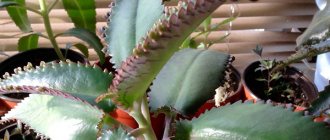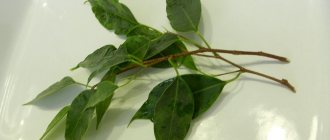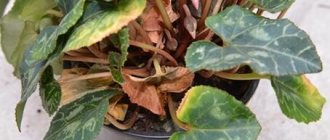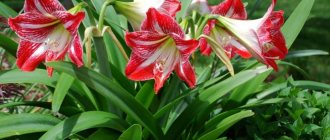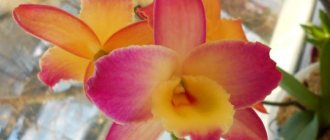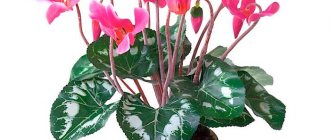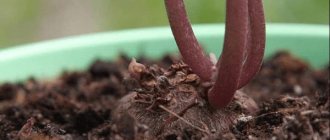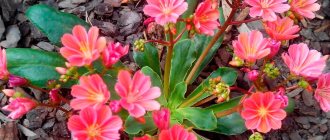general description
The heart-shaped leaves are dark green with jagged edges and have a beautiful silver pattern. The leaves are collected at the roots into a kind of rosette; they are located on dark burgundy petioles. Long peduncles are decorated with flowers of various shades. Pink, red, white, burgundy, purple - the color palette of cyclamen is replete with variety. The main feature of cyclamen is considered to be abundant flowering; traditionally this occurs in the autumn-spring period.
There are about 20 species of plants, but two types are popular in home floriculture: Persian and European. The only difference between them is the color of the flowers, the timing of flowering and the characteristics of transplantation.
There is an opinion that the plant is quite capricious and difficult to care for, but it is quite easy to grow, observing some rules and nuances.
Popular types
All types of cyclamens are divided according to height into three groups:
- short, with a height of 15 cm;
- medium-sized - about 20 cm;
- standard - height reaches 30 cm.
The following types of cyclamens are common in nature, differing in size, color and place of growth:
Persian
The Persian species is one of the most common varieties both in nature and in indoor floriculture. The tubers grow up to fifteen centimeters in diameter and have a flat-round shape. The leaves are dark green in color, covered with a silvery pattern and have a heart-shaped shape. The height of the peduncles is from fifteen to twenty centimeters, and the total height of the flower reaches thirty centimeters. The flowers are white, pink or red and have oblong petals about five centimeters long, set back from the corolla. The Persian species blooms from autumn to spring, and sheds its leaves in the summer. Many hybrid varieties for indoor floriculture have been bred based on Persian cyclamen.
European
European cyclamen is much less common among indoor flowers. It has some differences from the Persian type. The size of the leaves is three to four centimeters. In addition, the underside of the leaves has a purple tint. Its flowers are smaller, and the size of the petals does not exceed two centimeters. Flowers are white, red or pink. The main difference between European cyclamen is the flowering period. It blooms from May to September, and does not have a pronounced dormant period with the leaves drying out. Of course, in summer it is advisable to keep it at a temperature no higher than 25 degrees and in diffuse sunlight.
Cretan
Cretan cyclamen is found naturally on the island of Crete. It is small in size. Flowers are white and pink.
Kossky (photo by Andrey Pomidorov)
Kos cyclamen is found in the Caucasus. The low plant reaches only ten centimeters in height and can overwinter under the snow. The white or pink-red flowers have dark spots at the base of the petals.
Ivy (Neapolitan)
Ivy-leaved cyclamen has a second name - Neapolitan. It differs from other species in that the flowers appear first, and then the leaves.
This may be interesting: Echmea - care at home
Basic rules for flower care
Cyclomenia is relatively unpretentious in maintenance, however, like any plant, it loves care. In order for the plant to grow healthy and attractive, you must follow a number of simple rules for growing cyclomenia. Flower care:
- Watering and spraying. Cyclamen loves moderate watering; do not allow the plant to become waterlogged or dry out. It is recommended to water from below, pouring settled water into the pan and avoiding water getting on the leaves and base of the tuber, as this can provoke the appearance of the fungal disease gray rot. The flower does not tolerate spraying, but to increase humidity, you can spray moisture from a spray bottle around.
- The lighting is bright, but diffused, without direct sunlight, to avoid leaf burns. Window sills of western and eastern windows are perfect.
- Temperature is an important component for the abundant flowering of cyclamen. In winter 10-15 degrees, and in summer up to 25. Please note that the flower is very sensitive to temperature fluctuations and drafts.
- Air humidity. It is preferable to keep the plant away from heating devices. The best option is to place a tray of water or wet peat near the pot or place the plant on wet pebbles. The leaves can be wiped periodically with a damp cloth.
- Fertilizing should be done every two weeks, using complex fertilizers for indoor flowering plants. During the dormant period, do not feed the plant.
During flowering
Flowering lasts quite a long time . Subject to favorable indoor conditions and depending on the variety, cyclamen can bloom from October to March. The plant does not require special care during flowering. Moderate watering to the edge of the pot, maintaining humidity and coolness is the key to abundant flowering. It is better to fertilize with phosphorus-potassium fertilizers in half the recommended dose; nitrogen fertilizing promotes leaf growth, so they should be excluded during the flowering period. Transplanting cyclamen at this time is strictly not recommended.
The color of cyclamen is perfectly stored in a vase for up to three weeks; for this, their stem is cut by 2-3 cm and replaced every 2-3 days.
After the flowering period
It is also necessary to follow the rules of care after flowering.
When it stops, the leaves turn yellow and wither, it’s time for the plant to rest. During the dormant period, nutrients accumulate in the tubers, which will be consumed during the next flowering. It is necessary to remove peduncles and leaves, carefully twisting them without damaging the tubers. It is important to put the pot in a cool place. Watering during the dormant period should be significantly reduced, to a tablespoon per week. It is better to place the flower in a well-ventilated area. As soon as the cyclamen gives new leaves, it is necessary to return it to its usual place and resume the watering regime.
Home care
How to care at home? When caring for it, you should take into account the specifics of its life cycle - the presence of a phase of active growth (flowering) and a dormant period.
During the resting phase
After the end of the active growth phase, the wilted flowers are carefully removed from the plant . You should not trim them, as this can injure the plant. The flowers are carefully twisted at the base with a sharp movement. The leaves are not torn off so as not to damage the tuber; they fall off on their own. Watering is gradually reduced to a minimum.
After one tuber remains in the pot, you can:
- Take the pot with cyclamen into the garden or onto the balcony, placing it in a dark place, watering it occasionally to prevent the earthen ball from drying out. In August-September, the plant is returned to its original place and the amount of watering is increased.
- Dig up the tuber, wrap it in thick paper and put it in the vegetable drawer in the refrigerator until autumn. At the end of summer, the “preserved” tuber is taken out and planted.
- Watering is gradually reduced until it stops completely. After the last leaf has fallen, the pot with the remaining tuber is placed on its side. In July-August, the plant is replanted and watering is resumed.
With proper care, cyclamen blooms again after 2-3 months.
Transfer
When new leaves begin to grow, it is advisable to replant the plant. The transplant algorithm is simple :
- Choose a wide pot, 2-3 cm larger in diameter than the previous one. In a container that is too large, the plant produces fewer buds, and flowering becomes less lush and long-lasting.
- A drainage layer and prepared soil mixture are poured into the pot.
- The rhizome is carefully dug up, the soil is shaken off, leaving some on the tuber. The tuber is buried 2/3 into the ground.
- After transplantation, before flowering begins, complex mineral fertilizers for flowering plants are applied twice a month.
Features of transplantation
When choosing a flower, you should pay attention to the presence of buds; the tuber should be hard and heavy. After purchasing a cyclomenia flower, replanting and care are the main components of success. Store-bought primer is not intended for long-term use.
Cyclamen should be replanted as planned every year at the same time; it is better to do this with the appearance of new leaves, before budding begins. Transplantation plays an important role in the development of the plant. The soil becomes depleted over time and loses its beneficial properties, so it must be completely replaced and dead flower roots removed. For longevity and better flowering, the soil should consist of the following components:
- humus;
- sand;
- leaf soil;
- peat.
The finished mixture can be purchased in specialized stores or prepared yourself by mixing all the ingredients in equal parts. Add more leaf soil.
When choosing a pot for cyclamen, you should take into account the age of the flower. For a one-year-old cyclamen, the diameter should be no more than 8 cm, for three-year-olds - about 15 cm. A pot that is too large will contribute to excessive accumulation of moisture. Ideally, this is 2 cm from the tuber to the edge of the pot. The drainage system can be made with expanded clay or pebbles .
Immediately before planting, it is better to disinfect the soil by calcining it in the oven or treating it with a solution of potassium permanganate. The pot also requires disinfection. Place the earth mixture into the prepared container, but do not compact it. Carefully place the onion on top in the middle and cover it halfway with soil. The plant needs to be watered twice and, after waiting for the water to be completely absorbed, add more soil. Tubers of Persian cyclamen should be buried 2/3 in the ground, and European ones completely.
Emergency flower transplantation is carried out in the following cases:
- The appearance of pests.
- Root rotting.
European and Persian cyclamen differences
The most common species in indoor cultivation are Persian (Cyclamen persicum) and European (Cyclamen europaeum). Despite the fact that both species belong to the same genus, the presence of significant differences requires a more detailed acquaintance.
color of leaves and inflorescences
The color of the upper part of the leaf blade in both species is the same - dark green, but the lower part of the European one has a dark red color. The size of the leaves also varies - in the European species they are smaller. The color palette of the Persian is much wider, the European, as a rule, is presented in pink, the flowers are smaller in size, but with a pleasant aroma;
dormant and flowering period
The most significant indicator, since the Persian flowering period begins at the end of autumn and lasts throughout the winter, then the plant goes into dormancy mode. In turn, European cyclamen blooms in the spring and does not have such a pronounced rest period - the foliage does not turn yellow or fall off, the flower remains decorative throughout the year;
landing features
When planting Persian cyclamen, the tuber goes deep into the soil mixture to 2/3 of its height, the European tuber is completely covered with soil.
Based on the biological characteristics of the Persian species, purchasing a flower at the end of winter will not bring long-term pleasure; the best time to buy is the end of autumn or the beginning of winter.
If desired, you can choose decorative varieties of Persian cyclamen of different sizes: from standard, 30 cm high, to low-growing forms, no more than 15 cm high.
When purchasing, it is recommended to pay special attention to the appearance of the plant: the condition and color of the leaves - they should be elastic, rich in color; the number of unopened buds - a flowering plant has few of them. Video “Cyclamen, how the dormant period begins”
Video “Cyclamen, how the dormant period begins”
Reproduction methods
The process of propagating a cyclomenia flower and caring for it in this process is quite labor-intensive and requires patience and certain knowledge.
The flower can be propagated in two ways: by seeds and by dividing the tubers. Plants grown from seeds take longer to bloom. The optimal time for sowing is late summer. First, the seeds must be soaked in a 5% sugar solution, the floating seeds should be discarded, and the seeds that have sunk to the bottom should be soaked for a day in a solution of water and “Zircon” in a proportion of 5 drops per 0.5 liters of water. The seeds should be sown in a mixture of peat and soil, sprinkled on top with a thin layer.
It is better to cover the seedlings with a transparent film, periodically opening them for ventilation and watering. The optimal temperature for growing seeds is 20 degrees. Shoots should appear in 30-40 days. After which the container with seedlings needs to be moved to a well-lit and cool place. Small pinkish tubers will appear on the surface first; later, when two leaves form, you can start picking them into a separate pot.
Propagation by tubers is quite traumatic for the flower, so it is rarely carried out indoors. For division, take an old plant at rest. Before the procedure, you need to carefully examine the tuber for the presence of buds and root system and cut it so that both parts remain. After treating the cut area with charcoal, the tubers are given time to dry, then planted in pots.
Preparing and sowing seeds - step-by-step instructions
Growing cyclamen from seed material takes place in several stages.
Seed preparation
They are pre-soaked in any stimulant for 18 hours. Most often they use Zircon, Epin-extra or Etamon, which are sold in any flower shop. The drugs are diluted according to the instructions supplied with the drug.
You can soak the seeds in a weak solution of potassium permanganate or simply in warm water. Soak a piece of gauze folded in several layers or 2 cotton pads with the prepared liquids. Soak the seeds for 14 hours, and you must constantly monitor them so that they do not dry out.
At this stage, it is advisable to use different processing methods for several groups of seeds in order to later draw conclusions about the optimal soaking option.
Landing
In a special indoor greenhouse, which can be used as an opaque container, the prepared soil mixture is placed in a layer of 6–7 cm. The substrate is prepared from a mixture of leaf soil and peat in equal quantities. The soil is compacted well. The treated seeds are laid out at a distance of 2–3 cm, then sprinkled with a mixture of sand and peat in a layer of about a centimeter and watered generously.
To maintain a high level of humidity, the container with the sown seeds is covered with an opaque film or lid. The best conditions for germination are an air temperature no higher than +18ºС and a darkened room.
The germination process takes a very long time; the first shoots may appear in 30–40 days. At first they are a root with a small tuber. It takes root in the soil, after which pink-violet loops unfold from small nodules.
When sprouting, quite often a slight difficulty arises in that the first leaf does not manage to shed the seed skin for a long time, and it cannot unfold. Usually, with sufficiently high air humidity, seedlings solve this problem on their own, gradually shedding their scales, but sometimes they remain there for quite a long period.
There is no need to be afraid of this, since the next leaves will come from the nodule located in the soil
However, you can help the plant, for which the sprout is carefully covered with moistened cotton wool and left for an hour and a half. After this, the seed will become soft and can be easily removed from the shoot.
Another method is to use tweezers to remove the dried scales, but this risks damaging the sprout.
As soon as the first shoots appear, the container must be moved to a bright place, but not in direct sunlight. If you have difficulty finding such a place, then the plants need to be slightly protected from sunlight. Young seedlings need daily moistening from a watering can with a fine strainer, or using a spray bottle
It is equally important to observe the temperature regime in the room, maintaining it at +18ºС
Picking seedlings
Cyclamen seedlings dive when one true leaf is finally formed and a second one appears. At this point, the plant has already formed a small tuber. Seedlings are planted in pots or seedling boxes filled with soil consisting of equal parts of sand, leaf and turf soil.
You can place 2–3 seedlings in one bowl; they are placed in boxes according to the “6 by 6” pattern.
You need to dive carefully, picking up the seedling with a lump of earth. The resulting nodules must be completely covered with earth.
After the seedlings are planted, the plant begins to grow faster.
The planted young plants will take root in about 3 weeks, and a comfortable temperature for them should be maintained no higher than +20ºС. To prevent the petioles from stretching and curling, it is necessary to provide the plants with bright lighting. If for some reason it is impossible to arrange lighting, you need to lower the temperature. This step will slow down the growth of the flowers and protect them from deformation.
Transplantation to a permanent place
The bowl for rooted cyclamen should not be large, because as the seedlings grow, they are transplanted several times. The container must have a drain hole. The bottom is covered with a two-centimeter drainage layer (expanded clay, brick, pebbles or foam), then an earthen mixture is poured.
In addition to peat, sand and leaf soil are added to the soil. The seedlings are planted so that the nodules rise above the soil by a centimeter to one and a half centimeters
Water the flowers through a tray or carefully along the edge of the bowl, being careful not to wet the tubers and leaves.
Diseases and pests
Fusarium is a fungal disease that affects the vascular system of the plant and its tissues. The disease is also known as dry rot, dieback, or heart rot. The fungus clogs the plant's blood vessels and releases toxic substances, which leads to wilting and death of the flower.
Symptoms: yellowing of leaves starting from the tips. Often the lesion is observed on one side of the plant, while the second side may continue to grow, but without full flowering. When the tuber is cut, the affected bundles of blood vessels are visible.
Treatment: Fundazol 0.1% for root watering, Topsin-M 0.1% for spraying.
Wet rot is a dangerous bacterial disease that cannot be treated.
Symptoms: appear suddenly, the plant begins to wither, leaves and flower stalks wither, roots rot. A putrid smell characteristic of this disease appears from the tuber. The source of infection is water or an infected plant nearby. The bacterium enters the flower through wounds and cracks, as well as through cut sites.
Treatment: in this case it is impossible; the plant should be destroyed to avoid infecting other flowers.
Gray rot or mold is a fungal disease that affects plants weakened by improper maintenance. Very cold and damp air, incorrect flower placement, high planting density, excessive humidity, improper watering, with water getting on the leaves and tubers contribute to the spread of the disease.
Symptoms: gray mold is localized on leaves and peduncles, takes off when the wind blows. The affected areas subsequently darken and die.
Treatment: treating the plant with a fungicide, removing affected areas, ventilating the room, avoiding drafts and infrequent watering may well revive cyclamen.
Root rot is a fungal disease whose pathogens live in the soil. It often affects young crops, preventing their growth. The cause of the disease may be garden soil that is not treated before planting.
Symptoms: leaves turn pale due to lack of nutrition, dark spots appear on them.
Treatment: young cyclamen are difficult to treat, but adult crops can be saved. They need to remove the infected roots, wash them and treat them with a fungicide. Then transplant into sterilized soil.
Anthracnose is caused by a soil fungus that attacks the plant during the flowering period. Heat and humidity enhance the development of the disease.
Symptoms: the disease does not manifest itself in the early stages. You can notice it only at the beginning of flowering, when the flower stalks become distorted, twisted and do not develop into flowers. Subsequently, the disease affects the leaves, they turn yellow and dry out.
Treatment: Since the fungus affects the soil, it is recommended to disinfect. Affected flower stalks must be removed and the plant treated with a fungicide 2-3 times.
Houseplant varieties
Of all the species, of which there are 15-18, only two are grown at home. And these two are divided into different varieties. The differences are in color, terry, size, height. There is also a division according to the last parameter: low-growing cyclamen will grow only up to 15 cm, medium-sized ones stay at around 20 cm, and standard growth will not exceed 30 cm.
The tuber of the plant is poisonous, so when working with it, you need to wear gloves. The tubers are quite large, from 8 to 30 cm.
People who buy flowers prefer long-lasting flowering. Therefore, today many hybrids of different varieties of cyclamen with a very long flowering period have been bred.
Cyclamen persica
The Persian species of this plant is universally loved. The variety of hybrids can capture any imagination.
The leaves of this species are quite large, about 15 cm, and resemble a heart shape with a light pattern. The height of an adult plant is 28-30 cm.
The European variety can be confused with the Persian variety, but they are not at all the same plants. European cyclamen is a child of the Alpine mountains and occupies a decent range there. Hence the cute name “Alpine violet”.
This species has several distinctive features:
- Alpine violet does not lose leaves after flowering, but goes into retirement, maintaining a green cap;
- the Persian species blooms in winter, and the European species in summer;
- the Persian looks more luxurious due to the volume of the buds, while the European beauty has smaller inflorescences;
- the smell of alpine violet is more pronounced;
- European inflorescences are lighter;
- The color of the leaves of the European species is soft purple on the reverse side;
- long peduncles are crowned with spirally twisted five long petals of the inflorescence;
- A pleasant bonus can be considered the formation of daughter bulbs-nodules in the alpine violet, with which it is easier to propagate.
Cyclamen Kos
Kos is a Greek island in the Aegean Sea. In nature, you can find small cyclamen bushes with heart-shaped leaves; the bright colors of the flowers immediately catch the eye.
The color is dark at the base of the leaves, while the rest of the leaves are noticeably lighter. Interestingly, the leaves appear only at the end of the flowering period and remain on the plant throughout the winter dormancy period.
This variety is found not only in cozy apartments, but also in natural conditions.
- The characteristic color of the flowers is pink, although white-flowered hybrids can be seen in homes. The Neapolitan beauty has a root system located close to the surface.
- You can admire the blooms starting in winter and all spring; in addition, a magical aroma will hover near the bush. Leaves may appear both during and after flowering.
- The presence of small horns on the inflorescences can also be considered a feature of the species.
- The leaves are very reminiscent of ivy, hence the name cyclamen.
Admire the beauty of the numerous ivy hybrids!
Cyclamen Victoria
This variety is classified as a Persian species, although the frequency of flowering is close to its European counterpart. The flowering, which looks like a bunch of climbing butterflies, occurs in late autumn and long winter, which is very different from the variety.
Victoria is attractive due to the original color of the petals and their fringed edges.
The best decoration for a northern window sill
Cyclamen mix
Please note that if you see the mark “mix” on such flowers, this does not indicate a separate variety or hybrid. Most often, under this name you will purchase a representative of any variety of the Persian species
Modern cyclamens have different flowers compared to wild plants of this species. They come in dark purple, scarlet, pink, cream, and snow-white. Decorative hybrids with carved multi-colored petals are very popular. Very often, flower growers purchase mini-hybrids of cyclamen, small dense bushes with large flowers. They take root well in cool climates and garden or apartment conditions.
Persian cyclamen has high decorative properties. The plant has large, lush green foliage. The flowering period occurs at the end of autumn and beginning of spring. The flower produces purple, lilac, and pink buds. The most popular representatives are Striata, Spring Moth, Victoria, Pink.
At their summer cottage, many people grow Caucasian cyclamen or ivy-leaved (Neapolitan). They tolerate drought, temperature changes and high humidity well.
Disease Prevention
For prevention, medicinal preparations, thinning of plantings, and destruction of diseased shoots are used. In order to prevent flower infection by various types of pests, you should follow some recommendations:
- Disinfect the soil and pot before planting.
- Carry out regular inspection of the plant.
- Follow the rules of care and watering.
- Do not use high concentration nitrogen fertilizers.
- Carry out preventive treatment with a solution of onion and garlic (pour half a teaspoon of finely chopped onion and garlic into a glass of water, let it brew, store the solution in the refrigerator, dilute two tablespoons per liter of water for watering).
Why doesn't cyclamen bloom?
Cyclamen blooms only if all necessary care rules are maintained. Lack of watering, a small amount of light, and low humidity can cause a lack of flowering.
In addition, an important factor in the active flowering of cyclamen is how the flower rested during the dormant period. Flowering may be delayed if the shrub has been fertilized with liquid to increase the amount of foliage. In this case, the energy directed to flowering and nutrients go into the leaves, affecting the number of flowers.
Growing in the garden
Cyclamen can be a wonderful garden decoration . In order for it to delight you with flowering all season long, you should pay attention to some of the nuances of growing outdoors.
- The planting site should be protected from drafts and direct sunlight.
- It is worth planting in a special soil mixture, filling the planting holes with it.
- Follow the rules for caring for and watering the cyclomenia flower, avoiding water getting into the growing point.
- Faded flowers and dried leaves should be removed by twisting.
- The first fertilizing should be done a month after planting with liquid specialized fertilizer, subsequent ones as needed.
- Cover the plant with leaves for the winter.
Of course, cyclomenia cannot be called an unpretentious plant; it requires careful treatment and increased attention, but for the sake of beautiful flowers, so reminiscent of lurking butterflies, ready to fly upward, it is worth mastering all the subtleties and features of care.
Where to get seeds from?
If you are planning to grow cyclamen from seeds at home, then you need to prepare planting material. But where do you get the seeds? The easiest way is to buy them at a specialty store. There are a large number of different varieties and colors on sale. This option is optimal for beginning gardeners or for those who want to expand their collection of indoor plants. If there are already adult specimens at home, then seed material can be collected from them in order to grow cyclamen from seeds at home. For propagation to be successful, flowers must be pollinated. If there are no flying insects or wind in the apartment, you will have to do this yourself. But how to grow cyclamen from seeds? How to carry out pollination?
